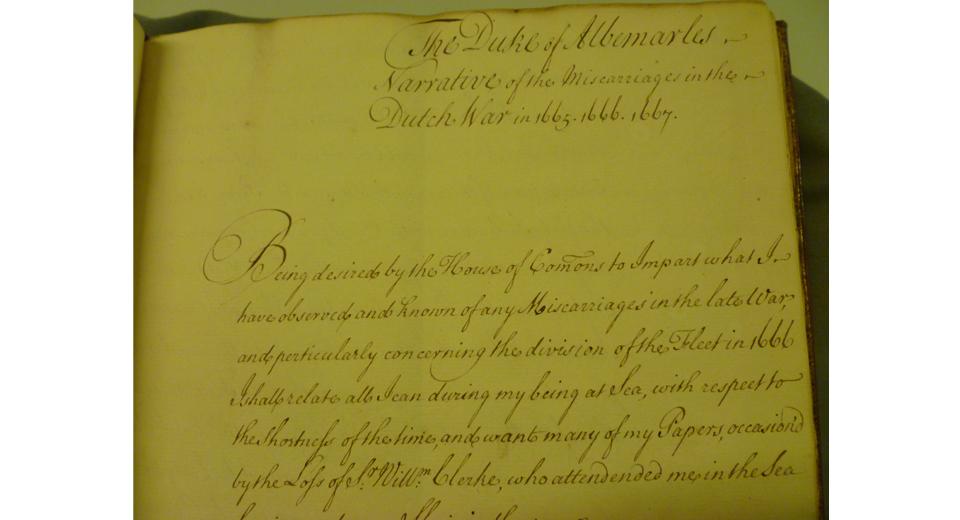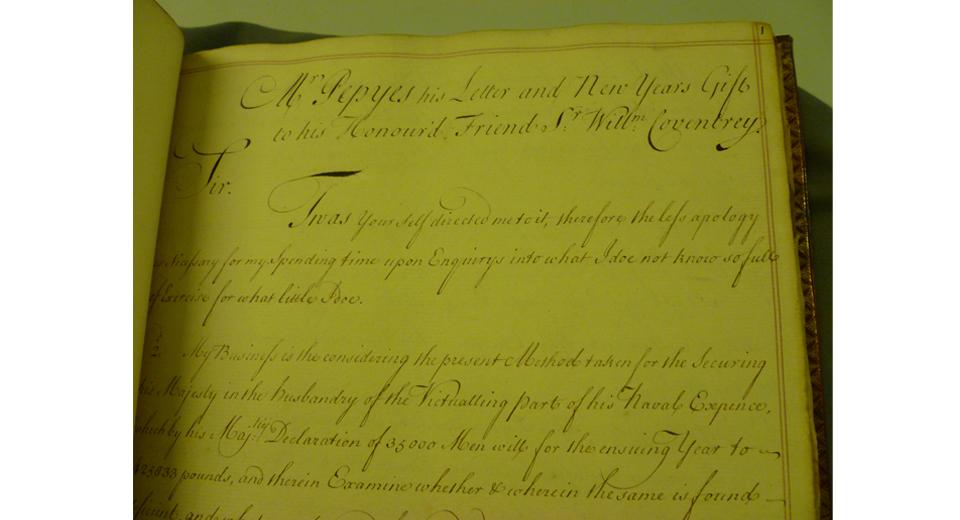Essential Information
| Location | |
|---|---|
13 Feb 2016
Tim Stanton, Retrieval Technician, delves into our archives.
I was intrigued by the world of Samuel Pepys, and wanted to explore what the archive had to offer on this fascinating period. Of the wide assortment of items within our collection it was CLU/2 that really caught my attention, as both its contents and the manner in which it was compiled provide a curious window into the world of Pepys and his contemporaries. Not to mention how this era began to be studied critically, shaped historically, and viewed subsequently by later generations.
CLU/2 is part of a group of manuscripts collected at Clumber House by Henry Pelham, fourth Duke of Newcastle (1785-1851), and comprised of numerous transcribed copies of administrative materials and official letters from the 17th and 18th Centuries. Whilst an invaluable source for the inner workings of naval administration in their own right, what makes these documents particularly notable are the individuals who compiled them. CLU/8, for example, was produced by William Locker (c.1731-1800) during his time as Lieutenant Governor at Greenwich Hospital (1793-1800), and was produced with the intent ‘to rescue, by the products of unquestionable evidence the characters of several worthy seamen officers from false aspersions which have been cast on them by violence or the malice of individuals’. Although he unfortunately passed away before the completion of his history, he managed to bequeath these documents to the subsequent Governor of Greenwich Hospital, John Charnock, who made frequent use of them whilst writing his 6 volume naval history, Biographia Navalis.
Though less can be said definitively about the compiler of CLU/2, it has been attributed to Josiah Burchett (c.1666-1746). During his illustrious, though occasionally turbulent, career Josiah found himself as Pepys “favourite clerk”, accompanying the diarist during the Tangier expedition of 1685, as well as more than 20 trips to the royal residence at Windsor. Burchett was abruptly dismissed from his role as clerk in 1687 however, for supposedly accepting bribes, with numerous of his extant letters to Pepys protesting this and imploring him to reconsider his dismissal. Though unsuccessful in this endeavour, Burchett did go on to have an impressive career as Admiralty Secretary, before being elected as an MP for Sandwich (1705-1713). What he is best remembered for however, is his reordering of the Admiralty files, which he used to produce his Complete History, the first naval history to be written from these records.

With this in mind, CLU/2 can be considered both a fascinating collection of key historical sources as well as a historically significant artefact in its own right, through the choices made in the selection and assembly of these materials within this volume. There are, for example, a number of documents relating to the Second Anglo-Dutch War (1665-1667), including The Duke of Abermarles’ Narrative of the Miscarriage in the Dutch War in 1665, 1666, 1667, as well as Prince Rupert: His Narrative, both describing key naval confrontations and, interestingly enough, focusing on the ‘perceived miscarriages’ of the naval administration. The theme of victualing in particular echoed in both accounts, with the Duke of Abermarle for example blaming a lack of provisions for why the fleet, after burning 52 of the opposing merchantmen and 4 men of war, in the August of 1666, could not push its advantage and confront the further 50 merchantmen coming 3 days later as, ‘we were forced for want of Provisions to draw off’’. No less vociferously, Prince Rupert’s Narrative decries ‘the intollerable neglect in supplying provisions during the whole Summers expedition’, making specific note of how supplies were often defective, lacking (‘the Gauge of the Beer Vessels’ for example ‘was Twenty Gallons in a Butt short of what it ought to be’), or on many occasions completely missing, with pursers holding only notes of credit for items rather than the supplies themselves.
This consistency in theme is interesting given that the volume also includes a transcribed copy of Pepys’s letter to Lord Coventry, regarding the state of the victualing of the Navy as it was at the end of 1665. This letter, written on January 1st 1666, was the product of a month’s frantic work by Pepys, having only been promoted to the role of Secretary General of the Victualing Board towards the end of November 1665. Remarkably, when read alongside his diary for the preceding month of December, there are a number of telling references to him meeting and discussing the matter with people he himself describes as “better acquainted” with the victualling process. Unsurprisingly, given his overreliance on these people, the letter itself focuses on assessing the competency of older victualing systems rather than proposing anything new, finally settling on an earlier system whereby ‘a Purser [is] subjected to Cheques in respect of Wages but exempted therefrom as to Victualls’.

Whether or not the letter collection was assembled by Burchett, when read in contrast with the shambolic reports given by Abermarle and Prince Rupert only a few months later, it is hard not to recognise the stark irony of Pepys’s letter from the beginning of the year. In this respect, CLU/2 not only provides some incredibly vivid descriptions of scenes from the second Anglo-Dutch War but, thanks to the choices made during collation, presents a rather tongue in cheek account of 17th Century victualling by a historian who may or may not have had an axe to grind with Pepys.
To explore our collection for yourself visit our Caird Library and Archive